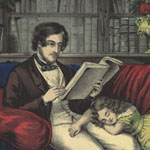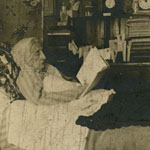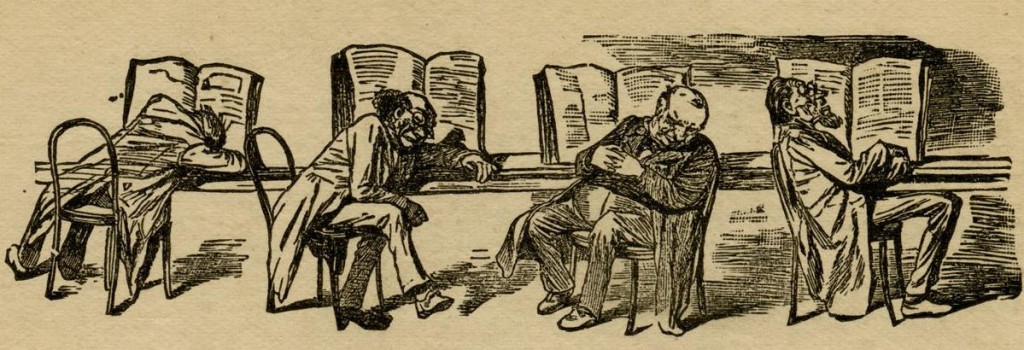A Place of Reading. That phrase defines Antiquarian Hall. Reading is an everyday occupation for those of us in Antiquarian Hall whether staff or, yes, readers.  But it is also part of the title for the newest online exhibition posted on the AAS website. How did this one come to pass? It started over twenty years ago when John Hench and I collaborated on a conference under the auspices of the Program in the History of the Book in American Culture on the iconography of reading. The idea had surfaced during an early PHBAC meeting and John and David Hall, the chairman of the Program, thought it would be of interest to a variety of scholars and might contribute to the then new book history field of studies. The conference was held in June of 1991 with ten presentations on reading in European and American contexts, ranging from early European examples to posters of women reading at the end of the nineteenth century. Although we had hoped that the presentations would be published by AAS, only Linda Docherty’s presentation on “The Open Book and the American Woman” appeared in the Proceedings of the American Antiquarian Society (available for sale on the AAS website as an offprint by clicking here).
But it is also part of the title for the newest online exhibition posted on the AAS website. How did this one come to pass? It started over twenty years ago when John Hench and I collaborated on a conference under the auspices of the Program in the History of the Book in American Culture on the iconography of reading. The idea had surfaced during an early PHBAC meeting and John and David Hall, the chairman of the Program, thought it would be of interest to a variety of scholars and might contribute to the then new book history field of studies. The conference was held in June of 1991 with ten presentations on reading in European and American contexts, ranging from early European examples to posters of women reading at the end of the nineteenth century. Although we had hoped that the presentations would be published by AAS, only Linda Docherty’s presentation on “The Open Book and the American Woman” appeared in the Proceedings of the American Antiquarian Society (available for sale on the AAS website as an offprint by clicking here).
In any event, I started to gather images of adults and children reading that accumulated in a file folder in my office filing cabinet. Over the years it became fatter and fatter. Fast forward to February of 2009 when Marla Miller, professor of history at the University of Massachusetts, Amherst, wrote to me asking if I could help a graduate student in the Public History program specializing in the history of the book think about internships. I was only too happy to discuss internship possibilities for Cheryl Harned at AAS. We have had wonderful experiences with interns in the graphic arts department. Over the past decade, they have created huge finding aids, created databases of visual materials, scanned visual materials, created fine online exhibitions, and generally accomplished many other tasks.  Cheryl and I discussed a few options and then I pulled out the folder with the fading photocopies. She quickly seized upon the idea of an exhibition on reading and started to work. The concept of an online exhibition responded nicely to the mission of the public history program: train graduate students to work on projects with a broad range audiences that hopefully will prepare them for work in an institutional setting, provide important services for regional organizations, and to advance through research and demonstration projects the theory of public history and how to service audiences beyond the university.
Cheryl and I discussed a few options and then I pulled out the folder with the fading photocopies. She quickly seized upon the idea of an exhibition on reading and started to work. The concept of an online exhibition responded nicely to the mission of the public history program: train graduate students to work on projects with a broad range audiences that hopefully will prepare them for work in an institutional setting, provide important services for regional organizations, and to advance through research and demonstration projects the theory of public history and how to service audiences beyond the university.
Cheryl went far beyond her course requirements in the preparation of this exhibition. It didn’t help that Lauren Hewes, Christine Ward-Graham, Jaclyn Penny, and I kept finding new images for her to incorporate in the exhibition. That’s why the innovative Image Bank of Reading Places was created! It was hard to stop. Cheryl planned the exhibition in chapters and found many wonderful first person accounts of reading. She wove her research and observations into an extraordinary text. Jaclyn Penny converted the long text file and many, many images into the exhibition that we all hope you will enjoy and use in your teaching and research. And, please add your own favorite images to A Place of Reading. The link to this continuing blog of images of reading can be accessed from the Image Bank of Reading Places, or directly at Addenda: Blog A Place of Reading.
Jackie has also put a sampling of the original images on display in the AAS reading room. Come by for the free public tour AAS offers every Wednesday afternoon at 3pm and you can see some of the original images used in the online exhibit (plus live readers!) in person.

